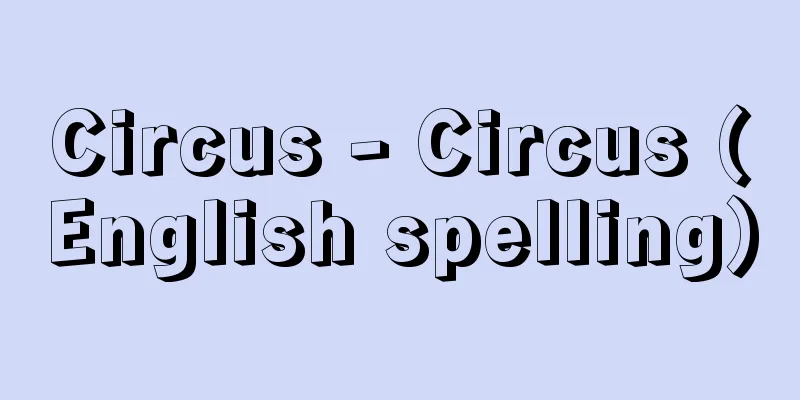Circus - Circus (English spelling)

|
A show consisting of highly skilled human and animal acrobatics. The word circus comes from the Latin circus, which means "ring." The origin of the circus is sometimes traced back to the ancient Roman amphitheater, the Circus Maximus, but although there is a connection in the words, it is better to distinguish it from the modern circus. The circus was modeled after the ancient Greek hippodrome, and is said to have been brought to Rome by the Etruscans, the indigenous people of the Italian peninsula. During the Roman Empire, it was built all over Europe as a large oval-shaped outdoor stadium (theater) where sports such as horse racing, chariot racing, martial arts, and hunting games were held, as well as spectacles. The circus as a form of entertainment today is not necessarily a historical extension of the circus. The modern circus developed with equestrian circus, not horse racing, as its main attraction, and new show formats were incorporated into it, growing into a form of entertainment. Therefore, here we will look at the history of the modern circus, starting from the famous British circus of Astley. [Minoru Tanokura and Keiichi Nishida] History of the CircusEuropePhilip Astley (1742-1814) of England was a horse-drawn non-commissioned officer in the army, but after retiring he bought several horses and held a horse-drawn circus show in a vacant lot called Halfpenny Hatch in London in 1768. This proved so popular that he built a temporary acrobatics center near Westminster Bridge, and the space for the acrobatics was designed to be circular, which became the prototype of the circus' distinctive ring. Thus, in 1770, the modern circus was born. This acrobatics center was eventually given a roof and given the appearance of a full-fledged theater, and was named the Astley Amphitheatre. Comical horse acrobatics and various other acrobatics and light tricks were introduced, and the groundwork was laid for the appearance of clowns, an indispensable feature of Western circuses, and a modern form that integrated folk entertainment was created. In Britain, Charles Hughes, an acrobat from the Astley Troupe, then established his own troupe, which he named Royal Circus in 1782, the first time the word "circus" was used. The Hughes Troupe eventually expanded into Russia, and his student J.B. Ricketts introduced circus to America, and Frank Brown to South America. While this new style of show spread around the world, an acrobat named Andrew Ducklow emerged from the Astley Troupe and became famous when he ran an amphitheater in 1825. The Sanger Troupe, which began performing in the latter half of the 19th century, was large in scale and gained fame, dominating the British circus world for a long time thereafter. The first full-scale circus (cirque) performance in France was a tour by the Astley troupe in 1776, but in 1783 the troupe built an English-style amphitheatre in Paris, and the Italian acrobat Antonio Franconi (1738-1836) joined, which made a great leap forward. In 1807, he and his two sons opened the Cirque Olympique in Paris. In 1841, the Cirque des Champs-Élysées, designed by architect Itoff, opened, and in 1852, another Cirque Napoleon, also designed by Itoff, was built. In the second half of the 19th century, a huge outdoor theater called the Hippodrome was built, and the circus in France became a representative form of entertainment for the masses. The first to establish a major circus empire in Germany was the E. J. Lenz troupe, which rose to prominence in Berlin around 1847. The Hagenbeck Circus, which began performing animal shows in Hamburg in 1848, and the Schumann Circus, which appeared in Berlin in 1893, both grew to become the leading troupes in Europe. Thus, the circus quickly spread from England to France and then to other European countries, but Italy cannot be overlooked as a country that supplied acrobats and clowns. At the time, Italy only had small troupes such as Chiarini, Zaverda, and Zoppe, but in the 20th century, two major circuses, Orfeo and Darlix Toni, came to dominate the market. Spain is also a developing country when it comes to circuses, but it has made a historical contribution to the field of high equestrianism. In Russia, the British Hughes troupe performed during the reign of Catherine the Great (reigned 1762-1796), and in 1845 the Italian Alessandro Guerra formed a troupe and performed in St. Petersburg. The Paris Circus led by Paul Cusin joined them, paving the way for the creation of Russian circuses. The first was the Nikitinu brothers' circus troupe, which eventually built permanent theaters in various cities in Russia. After the October Revolution (1917), Lenin's policies led to the establishment of national circus troupes including Salamonsky and Nikitinu, and in 1927 a national circus school was also opened. [Minoru Tanokura and Keiichi Nishida] AmericaThe origin of the American circus was J.B. Ricketts of the Astley Troupe, who established a circus in Philadelphia in 1793. Since then, circus performances have flourished in America, developing faster than in Europe, reaching their peak with the appearance of P.T. Barnum Phineas Taylor Barnum (1810-1891). He started out by putting on spectacles featuring giant animals and deformed humans, and in 1871 he founded a circus company, which he later merged with J.A. Bailey's circus company, and in 1876 Barnum & Bailey's "The Greatest Show on Earth" was born. Traveling tents became huge, accommodating 10,000 people and equipped with three rings. In 1882, the Ringling Circus appeared, and American circuses, supported by huge entertainment capital, dominated the world of popular entertainment at the end of the 19th century. [Minoru Tanokura and Keiichi Nishida] China and KoreaThe history of Chinese acrobatics is long, said to have begun with the Chiyou Opera from the ancient period. This came to be called Hyakugi by around the 6th century, and became Sangaku during the Sui dynasty, being introduced to Japan during the Nara period. Meanwhile, various Hyakugi, Sangaku and illusions were introduced to China from the Western Regions, and gradually took the form of acrobatics and spectacles. These historical acrobatics traditions are the basis of Chinese circuses, which often focused on training human skills and rarely used animals, but in recent years, efforts have also been made to train animals. In modern China, circuses are called acrobatics (tsachi), and troupes are formed in each city, with the number of such troupes reaching about 30. Korean circuses are new and have no connection with traditional circus troupes such as the Namsadang. They were formed from Japanese circuses that traveled to Korea and China before World War II, and currently there are six circus troupes active in Korea. [Minoru Tanokura and Keiichi Nishida] JapanThe beginning of the modern circus in Japan can be traced back to 1864 (Genji 1), when various types of spectacles were popular, and was triggered by the performance of "Chu-tenji Imported Acrobatics" by the Risley Troupe in the Yokohama Foreign Settlement. This was followed by the influence of foreign circus troupes that came to Japan one after another. As a result, troupes that had previously been independent for different types of performances, such as acrobatics, footwork, and equestrianism, began to come together, and the foundations of the modern circus were formed in the early Meiji period. The one that had the greatest influence among the circus troupes that came to Japan was the Grande Charine Equestrian Troupe, which visited in 1886 (Meiji 19) and 1889. The name "Charine" probably comes from the Italian Chiarini, and at one time in Japan it became synonymous with circus-style spectacles, and in the 1880s and 1890s a troupe named "Charine" was born. A representative example is Yamamoto Seitaro's "Japanese Charine Troupe," founded in 1899. As circus-like performance formats were established under foreign influence, some of the traditional Japanese spectacles fell into decline, while others were carried over in a modified form into the modern circus. One example of a spectacle that fell into decline was Japanese horseplay. This is thought to be because, as a spectacle that incorporated elements of Kabuki rather than acrobatics, it did not match the circus performances that focused on speed and thrills. The golden age of modern circus in Japan was started by the German Hagenbeck Circus, which came to Japan in 1933 (Showa 8) to celebrate the International Women's and Children's Exposition. In addition to the sheer scale of the show, people were astonished by the exceptional admission fee of just four yen for first-class tickets, which was an incredible amount at the time, and this completely rewrote people's perception of the circus. The famous "Circus Song," along with "Beautiful Natural," which represents the melancholy of the circus, are songs included on the B-side of "The Circus Comes," a welcome record commemorating Hagenbeck's visit to Japan. This marked the golden age of modern Japanese circuses, with over 30 troupes changing their names to circus troupes, but they were forced to disband one after another during World War II. However, circuses quickly returned after the war, performing under the open sky without tents, and once again became prosperous. There are currently six circus troupes in Japan: Kinoshita, Kigre, Yano, Kakinuma, Holiday, and International, none of which have permanent tent structures and continue to perform in tents. [Minoru Tanokura and Keiichi Nishida] Modern CircusLarge circus companies such as Hagenbeck in Germany and Ringling in the United States, which absorbed Barnum & Bailey, lost their central position as entertainment for the masses as music hall shows and visual theater developed in the 20th century. On the other hand, circuses attracted the interest of writers, artists, and theater people, and were often depicted in works. The Ferdinand Circus and the Medlar Circus in France in particular were beloved by many writers and artists. However, the circus continued to decline, and many circus troupes disappeared during World War II. After the war, the circus further declined due to the diversification of entertainment such as movies and television, and it never regained its former prosperity. Attempts to reevaluate the circus and revive it as a new form of entertainment for the masses began in the 1960s, and now many countries are providing financial support to circus troupes. In particular, in socialist countries such as the former Soviet Union, circuses were fostered and protected by the state, and boasted techniques and organizations that surpassed those of Western countries. On the other hand, one of the characteristics of Western countries is that circus troupes are becoming international in nature, and one example of this is the Monte Carlo International Circus Festival, which came to Japan in 1980 (Showa 55), where impresarios gathered talent from all over the world to hold large-scale performances. Modern circuses in Japan face the same challenges as other countries around the world, including the diversification of entertainment, the difficulty of securing venues for performances, and the considerable expenses required for each performance. In particular, the Child Welfare Act and the Labor Standards Act, enacted in 1948 (Showa 23), prohibited minors from performing acrobatics, and these restrictions remain to this day, leaving major problems in the passing on of the art and training successors. In 1979, the "Circus Hall Realization Preparation Committee" (renamed the "Circus Culture Association" in 1984) was established, and published the quarterly circus newspaper "Equestrian Circus and Acrobatics," but the association was dissolved in 2004 (Heisei 16). [Minoru Tanokura and Keiichi Nishida] Circus performancesThey can be broadly divided into those that focus on human performances using tools, those that focus on animal performances, and those that focus on clown performances. The star of the circus is the flying trapeze, which is called "shumokumono" in Japan. There are trapeze acts such as the big trapeze, the small trapeze, and the two trapeze, but the most popular is the "aerial flight," in which the jumper performs a flight that includes rotations and twists around the receiver, called the "chūdai." Next are the balancing acts known as "kajimono," such as "tightrope walking" and "wire walking." "Ikou-watari" (walking on a bamboo pole) is one such act, in which performers swing a bamboo pole hanging from both ends back and forth while performing various hand tricks. There were also acts such as "saka-zuna," which used a sloped rope, and "yotsu-zuna," which used ropes stretched crosswise, but these are no longer seen in modern Japanese circuses. "Foot tricks" include "funbari-mono," which support heavy objects, "tsutsubari-mono," which use ladders and other objects to maintain balance, and "koashi-mono," which manipulate light objects such as sliding doors, barrels, and umbrellas with greater dexterity than the hands can. The "ningyoku" trick, in which two foot performers kick and catch an entertainer called an "upper performer" like a ball, has disappeared from Japanese circuses today because it is considered cruel, but the Bolshoi Circus often brings this trick to Japan when it comes to performing. In the "shoulder performance," bamboo or a ladder is supported by the shoulders, and the upper performer performs various tricks on it, such as the "single bamboo," "flying," "flag waku," and "breaking ladder." The world of the circus tent is completed by adding animal acts such as horseback riding, lions, tigers, elephants, bears, chimpanzees, and dogs, and clowns. In Japan, all clowns are called pierrots, but circus clowns should be called clowns. In today's Japanese circuses, there are other types of performances, such as the iron haul, where performers ride motorcycles around inside an iron ball, aerial bicycles on wires, unicycles, seven-stool chairs, revolving ladders, and rope suspension. The most uniquely Japanese performances are thought to be foot and shoulder performances, but each country has its own characteristics: acrobatics in China, the use of various machines in Russia, trapeze jumping in the United States and Mexico, and animal training in Russia and Germany. [Minoru Tanokura and Keiichi Nishida] "Japanese Circus" by Ozaki Koji (1958, Sanme Shobo)" ▽ "The History of the Circus" by Akune Iwao (1977, Nishida Shoten)" ▽ "Chinese Acrobatic Arts" edited by the Shanghai Acrobatic Troupe (1980, Shanghai Literature Publishing)" ▽ "Special Edition Shinpyo: The World of the Circus" (1981, Shinpyosha) ▽ "Arts Series 2: Wandering - The World of the Circus" edited by Minami Hiroshi et al. (1981, Hakusuisha) [References] | | | | |Copperplate engraving of a Royal Circus performance, 1809, Metropolitan Museum of Art . "Royal Circus" A nishiki-e (colored woodblock print) depicting a performance held in Yokohama in March 1864 (Genji 1) ( Owned by the National Diet Library ) Utagawa Yoshitora, "Illustration of Acrobatic Performances Imported from Central India" Performance of the Grand Circus of Charinet, which visited Japan. 1886 (Meiji 19). Owned by the National Diet Library . Yoshu Shuen, "A Picture of a Tour of the Great Circus and Horse Racing" Source: Shogakukan Encyclopedia Nipponica About Encyclopedia Nipponica Information | Legend |
|
高度な熟練による人間と動物の曲芸などで構成される見せ物。サーカスの語源はラテン語キルクスcircusで、「輪」を意味する。 サーカスの起源を古代ローマの円形競技場キルクス・マクシムスCircus Maximusに置くことがあるが、ことばとしてのつながりはあっても、近代サーカスとは区別したほうがよい。このキルクスは古代ギリシアの競馬場に原型をもち、イタリア半島の先住民族エトルリア人がローマに伝えたとされ、ローマ帝国時代、ヨーロッパ各地に建設されて、競馬、戦車の競走、格闘技、狩猟競技などのスポーツをはじめ、見せ物も上演した楕円(だえん)形の野外大競技場(劇場)であった。今日の娯楽形態としてのサーカスはかならずしもその歴史的延長線上にあるわけではない。近代サーカスは、競馬ではなく曲馬を主要な演目として発展しつつ、そこに新しいショー形式が取り入れられ、興行として成長してきたものである。したがってここでは、有名なイギリスのアストリーの曲馬興行を起点として、近代サーカスの歴史をみることにする。 [田之倉稔・西田敬一] サーカスの歴史ヨーロッパイギリスのフィリップ・アストリーPhilip Astley(1742―1814)は陸軍の調馬下士官であったが、数頭の馬を購入して退役し、ロンドンのハーフペニー・ハッチという空き地で1768年に曲馬のショーを行った。これが人気をよんだため、彼はウェストミンスター橋の近くに仮設の曲馬場をつくったが、曲馬を演ずるスペースは円形に設計されてサーカス独特のリングの原型となった。1770年こうして近代サーカスは誕生した。この曲馬場にはやがて屋根がつき、さらに本格的な劇場建築の体裁を整え、アストリー・アンフィシアターAmphitheatreと名づけられた。そしてコミカルな曲馬をはじめさまざまな曲芸や軽業(かるわざ)が導入され、欧米のサーカスには不可欠の道化(クラウン)登場の下地もでき、民衆芸能を統合した近代的形態がつくられていった。イギリスでは、ついでアストリー一座の曲馬師チャールズ・ヒューズCharles Hughesが独立して一座を創立、1782年にロイヤル・サーカスと銘打ったが、ここで初めてサーカスということばが使われている。ヒューズ一座はやがてロシアにも進出、またその弟子のJ・B・リケッツはアメリカに、フランク・ブラウンは南アメリカにサーカスを紹介した。こうして世界各地に新しい形式のショーが広まる一方、アストリー一座からはアンドリュー・ダクローという曲馬曲芸師が現れ、1825年アンフィシアターを経営して一世を風靡(ふうび)した。また19世紀後半から活動を始めたサンガー一座は規模も大きく、名声もあがり、以後長い間イギリスのサーカス界に君臨した。 フランスでの本格的なサーカス(シルクcirque)の公演は1776年のアストリー一座による巡業が最初であるが、1783年には同座によってパリにイギリス・スタイルのアンフィシアターが建設され、これにイタリアの曲馬師アントニオ・フランコーニAntonio Franconi(1738―1836)が加わって大躍進を遂げる。1807年、彼は2人の息子とともにパリにシルク・オランピークを開いた。1841年には建築家イトフ設計のシルク・デ・シャンゼリゼが開場、1852年にはイトフのもう一つのシルク・ナポレオンも建設された。また、19世紀後半にはイポドロームという巨大な野外劇場もつくられ、フランスにおけるサーカスは民衆の娯楽を代表するものとなった。 ドイツに一大サーカス王国を築いたのは、まず1847年ごろにベルリンで頭角を現したE・J・レンツ一座であり、1848年にハンブルクで動物ショーを始めたハーゲンベック・サーカス、1893年にベルリンに登場したシューマン・サーカスは、ともにヨーロッパ随一の一座へと成長していった。 このようにサーカスはイギリスからフランスを経て、たちまちヨーロッパ各国へと広がっていくが、イタリアも曲芸師や道化師を供給する国として見逃せない。当時でこそイタリアはキアリーニ、ザバーダ、ゾッペなど小規模の一座を擁するにすぎなかったが、20世紀になるとオルフェオとダーリックス・トニーの二大サーカスが市場を席捲(せっけん)するまでになる。スペインもサーカスに関しては後進国であるが、高等馬術の領域で歴史的な貢献をしている。 ロシアではエカチェリーナ2世(在位1762~1796)の時代にイギリスのヒューズ一座が来演しているが、1845年にはイタリア人のアレッサンドロ・グエッラが一座を組んでペテルブルグで興行した。これにポール・キュザンの率いるパリ・サーカスが加わって、ロシアのサーカス団の創設を用意する。ニキチヌ三兄弟のサーカス団がその最初で、やがて彼らはロシアの各都市に常設の劇場をつくっていった。十月革命(1917)後、レーニンの政策によって、サラモンスキー、ニキチヌなどの国立サーカス団が発足、1927年には国立のサーカス学校も開設された。 [田之倉稔・西田敬一] アメリカアメリカのサーカスの始祖はアストリー一座のJ・B・リケッツで、1793年にフィラデルフィアにサーカス場をつくったが、以来サーカス興行は盛んで、ヨーロッパをしのぐ速さで発展を遂げ、P・T・バーナムPhineas Taylor Barnum(1810―1891)が登場するに及んで頂点に達する。彼は巨大な動物や異形の人間を見せる見せ物の興行からスタートして、1871年にサーカス団を創設、さらにJ・A・ベイリーのサーカス団を合併し、1876年にはバーナム・アンド・ベイリーの「地上最大のショー」が生まれた。巡業用テントは巨大化して1万人を収容、三つのリングを備えるに至った。また1882年にはリングリング・サーカスが現れ、巨大な興行資本に支えられたアメリカのサーカスは19世紀末の大衆娯楽の世界を支配した。 [田之倉稔・西田敬一] 中国・朝鮮中国の曲芸の歴史は古く、上古時代の蚩尤戯(しゆうぎ)から始まるといわれる。これが6世紀ごろまでに百戯(ひゃくぎ)とよばれるようになり、隋(ずい)代に散楽(さんがく)となって奈良時代の日本に伝来してくるが、その間に中国では西域(せいいき)から各種の百戯、散楽や幻術が伝わり、しだいに曲芸、見せ物としての形をなしていった。中国のサーカスの基底にはこれら歴史的な曲芸の伝統があって、人間の技芸の鍛練を中心としたものが多く、動物はほとんど使わなかったが、近年動物の調教にも力を入れている。現在の中国ではサーカスのことを雑技(ツァーチー)とよび、各都市ごとに団が結成され、その数は約30に上る。 韓国のサーカスは新しく、伝統的な雑芸集団である男寺党(ナムサダン)などとの交流はない。その母体となったのは、おもに第二次世界大戦前に朝鮮や中国へ渡った日本のサーカスで、現在六つのサーカス団が活躍している。 [田之倉稔・西田敬一] 日本日本における近代サーカスの始まりは、各種見せ物が人気を博していた江戸時代末期の1864年(元治1)横浜の居留地内で興行されたリズレー一座の「中天竺(ちゅうてんじく)舶来軽業」を契機にして、その後次々に来日した外国サーカス団による影響に求められよう。これによって、それまで軽業、足芸、曲馬など芸種別に独立していた一座がまとまり始め、明治初期には近代サーカスの素地が形づくられていった。来日したサーカス団のなかでとくに強い影響を与えたのは、1886年(明治19)と1889年に来日した「チャリネ大曲馬団」であった。チャリネとは、イタリア人キアリーニChiariniに由来するのであろうが、これが一時期の日本ではサーカス風見せ物の代名詞ともなり、明治20、30年代にはチャリネを名のる一座も生まれた。その代表的なものに、1899年に発足した山本精太郎の「日本のチャリネ一座」がある。 こうして外国の影響下にサーカス的な興行形態が整えられていくなかで、従来の日本の伝統的な見せ物の一部は衰退し、あるものは形を変えながら近代サーカスへと引き継がれていく。衰退したものの代表に日本曲馬(馬芝居)があげられる。これは曲乗りよりも歌舞伎(かぶき)の趣向を加えた見せ物だっただけに、スピードやスリルが主軸であるサーカス興行にマッチしなかったためと考えられる。 日本の近代サーカスに黄金時代を築く幕開きとなったのは、1933年(昭和8)万国婦人子供博覧会を記念して来日したドイツのハーゲンベック・サーカス団である。そのスケールの大きさに加え、特等4円という当時としては破格の入場料に人々は仰天し、サーカスに対する認識を大きく書き換えることとなった。サーカスの哀愁を代表する『美しき天然』とともに有名な『サーカスの唄(うた)』は、このハーゲンベック来日記念歓迎レコード『来る来るサーカス』のB面に収められた歌である。 これを機にチャリネ、軽業団、曲馬団を名のっていた一座の多くがサーカス団と名前をかえ、その数30以上といわれた日本近代サーカスの黄金期を迎えるが、第二次世界大戦時に次々と解散に追い込まれた。しかし、サーカスは戦後いち早くテントもないままの青空の下での興行などによって復活し、ふたたび活況を呈した。現在の日本のサーカス団は木下、キグレ、矢野、カキヌマ、ホリデイン、国際の6団体で、いずれも常設小屋をもたず、テント興行を続けている。 [田之倉稔・西田敬一] 現代のサーカスドイツのハーゲンベックや、バーナム・アンド・ベイリーを吸収したアメリカのリングリングなどの巨大なサーカス団も、20世紀に入ってミュージック・ホールのショーや視覚的な演劇が発達するにつれて、民衆娯楽の中心的地位を失っていく。しかしその一方で、サーカスは文学者、画家、演劇人の関心を集め、しばしば作品化されるようになった。とくにフランスのフェルディナンド・サーカスやメドラー・サーカスは、多くの文学者や画家に愛好された。 しかしサーカスの衰微は続き、第二次世界大戦中には多くのサーカス団が姿を消し、戦後は映画やテレビなど娯楽の多様化によってサーカスはいよいよ衰退し、往時の活況を取り戻すことはできなかった。このサーカスを再評価し、新たな民衆の娯楽として復活させようとする試みが、1960年代から始まり、現在ではサーカス団に財政的援助を与える国も多くなってきている。とくに、かつてのソ連をはじめとする社会主義諸国では、サーカスは国家によって育成保護され、西側諸国をしのぐ技術と組織を誇った。一方、西側諸国では、サーカス団が国際的編成になってきているのが特色の一つで、1980年(昭和55)に来日したモンテ・カルロ国際サーカスフェスティバルのように、興行師が世界各国から人材を集めて大規模の公演を行ったのもその一例である。 日本の現代サーカスも、娯楽の多様化、興行地の確保の困難、一興行に相当の経費がかかることなど、世界各国と同じ困難に直面している。とくに1948年(昭和23)に制定された児童福祉法、労働基準法などによって、年少者の曲芸が禁止され、その制限が今日まで続いているために、芸の継承、後継者の育成に大きな問題を残している。なお1979年に「サーカス館実現準備委員会」(1984年に「サーカス文化の会」と改称)が設立され、季刊サーカス新聞『曲馬と曲芸』を発行していたが、会は2004年(平成16)に解散している。 [田之倉稔・西田敬一] サーカスの演目道具などを使っての人間の技芸を中心にしたものと、動物の芸、それに道化の芸に大きく分けられよう。 なんといってもサーカスの花形は空中ブランコで、日本では「撞木(しゅもく)もの」とよばれる。大一丁(おおいっちょう)ブランコ、小一丁(こいっちょう)ブランコ、二丁ブランコなどブランコ上での芸もあるが、もっとも人気があるのは「空中飛行」で、中台とよばれる受け手を中心に、飛び手が回転・ひねりなどを加えた飛行をみせる。 ついで、「綱渡り」や「針金渡り」など、「カジもの」とよばれるバランスをとる芸がある。「衣桁(いこう)渡り(青竹渡り)」もその一つで、両端を吊(つ)った竹を前後に揺すって渡りながらさまざまな手事(てごと)をする。勾配(こうばい)をつけた綱での「坂綱」や十字に張った綱での「四つ綱」などもあったが、現在の日本のサーカスではみられない。「足芸」には、重いものを支える「ふんばりもの」、梯子(はしご)などを使ってバランスをとる「突っ張りもの」、襖(ふすま)や樽(たる)、傘のような軽いものを手以上に器用に操る「小足もの」などがある。上乗りとよばれる芸人を、2人の足芸の芸人が毬(まり)のように蹴(け)り、受け止める「人曲(にんぎょく)」という芸は、残酷ということで現在の日本のサーカスからは消えているが、来日するボリショイ・サーカスはよくこの芸をもってくる。「肩芸」は、肩で竹や梯子を支え、その上で上乗り芸人がさまざまな芸を演じるもので、「一本竹」「はね出し」「旗わく」「くだけ梯子」などがある。 これらの人間の演ずる芸に、曲馬をはじめ、ライオン、トラ、ゾウ、クマ、チンパンジー、イヌなどの動物芸が加わり、道化のクラウンが活躍して、サーカスの天幕の世界はできあがる。日本では道化はすべてピエロとよばれているが、本来、サーカスの道化はクラウンとよばれるべきである。 現在の日本のサーカスでは、このほかに、オートバイに乗って鉄製の球の中を回るアイアンホール、針金上での空中自転車、一輪車、七丁椅子(いす)、回転梯子(はしご)、吊りロープなどがある。日本独自の芸のトップは足芸、肩芸と思われるが、中国ではアクロバット、ロシアではさまざまな機械類を用いるもの、アメリカ、メキシコでは空中ブランコ、動物の調教はロシア、ドイツなどと、それぞれ国によって特徴がある。 [田之倉稔・西田敬一] 『尾崎宏次著『日本のサーカス』(1958・三芽書房)』▽『阿久根巌著『サーカスの歴史』(1977・西田書店)』▽『上海雑技団編『中国雑技芸術』(1980・上海文芸出版)』▽『『別冊新評 サーカスの世界』(1981・新評社)』▽『南博他編『芸双書2 さすらう――サーカスの世界』(1981・白水社)』 [参照項目] | | | | |銅版画に描かれたロイヤル・サーカスの公演。1809年メトロポリタン美術館所蔵"> 「ロイヤル・サーカス」 1864年(元治1)3月、横浜での興行を伝える錦絵国立国会図書館所蔵"> 歌川芳虎『中天竺舶来之軽業興行之図』 来日した「チャリネ大曲馬団」の興行。1886年(明治19)国立国会図書館所蔵"> 楊洲周延『チャリ子大曲馬御遊覧の図』 出典 小学館 日本大百科全書(ニッポニカ)日本大百科全書(ニッポニカ)について 情報 | 凡例 |
Recommend
Brewster's law
This is a law related to the reflection of light,...
Vertical line deviation - ENCHOKU SENHENSA
The angle between an actual vertical line at a poi...
Nylon - Nairon (English spelling)
It was the product name of a synthetic fiber inve...
Dmitrii Ivanovich Donskoi
1350‐89 Grand Prince of Moscow. At the age of eigh...
Cardamine
...A biennial plant of the Brassicaceae family (i...
Safety analysis
...The later in the development process safety is...
Arauco War - Arauco War
...They also knew about wooden houses, pottery, a...
The expected human image
…The Central Council for Education's October ...
Koyoshigawa
A river in southern Akita Prefecture. It is 61 km ...
Malines
…A city in the province of Antwerp in northern Be...
Ionosonde
...the movement of electrons in the ionosphere is...
carbonium ion
...A term that is the opposite of carbanion, and ...
Janibeg Khan (English spelling)
...The first time the ethnic name appears in hist...
Ikejiri family - Ikegamike
…Aristocrats descended from the Northern branch o...
Riko system - Rikosei
A village organization (li was called fang in cit...









